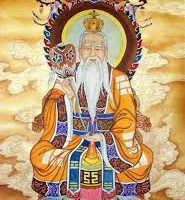Li Hong : The Daoist Messiah of Cosmic Renewal
Listen
At a glance
| Description | |
|---|---|
| Origin | Chinese Mythology |
| Classification | Mortals |
| Family Members | N/A |
| Region | China |
| Associated With | Prophecy, Messiah |
Li Hong
Introduction
Li Hong stands as one of the most compelling messianic figures in Daoist eschatology, symbolizing the hope of renewal during times of disorder. His presence emerges in early Chinese religious literature, particularly from the later Han dynasty onward, where communities grappling with political collapse, famine, and social unrest found meaning in prophecies foretelling his arrival. Rather than functioning as a warrior-messiah, Li Hong represents a restorative force—someone destined to realign heaven, earth, and humanity at the end of a cosmic age.
Daoist texts describe him not as a deity removed from the world but as a transformative leader whose appearance marks the beginning of a purified era. His coming is tied to cycles of decline: when corruption intensifies, virtues fade, and natural disasters signal the imbalance of the cosmos, Li Hong is expected to descend as a redeemer. His association with Laozi, often interpreted as a spiritual connection or future manifestation rather than literal reincarnation, positions him within the deepest philosophical roots of Daoism. In this way, Li Hong embodies both the wisdom of antiquity and the promise of a renewed world order.
Over centuries, his image extended far beyond religious texts. Waves of political movements, secret societies, and rebel leaders invoked his name as a symbol of legitimacy and moral authority. For many, Li Hong was not only a prophetic savior but a lens through which communities understood crisis, hope, and the possibility of transformation.
Physical Traits
Li Hong’s physical traits remain largely undefined in Daoist literature, which prioritizes cosmic symbolism over corporeal details. Instead of presenting him through a specific image, texts portray him through signs of spiritual authority—talismans, incantations, celestial omens, and the virtues he embodies. This indeterminacy allowed Li Hong to function as a universal archetype rather than a fixed character, enabling diverse groups to imagine him according to their historical context.
Some eschatological writings suggest he appears youthful yet timeless, reflecting the Daoist ideal of spiritual refinement. Others describe the aura surrounding him more than the man himself, depicting radiant signs or heavenly phenomena that indicate his identity. In most cases, Li Hong’s recognition depends not on his facial features but on the cosmic events that accompany his arrival. This deliberate vagueness ensures that his figure remains adaptable, allowing multiple movements throughout Chinese history to align their leaders with Li Hong’s prophetic identity.
Family
Mythological accounts of Li Hong rarely, if ever, describe a biological family. His narrative functions outside the standard genealogical frameworks common in Chinese myth, where heroes often trace ancestry to divine or legendary lineages. Instead, Li Hong’s connection is spiritual: he is linked symbolically to Laozi, sharing both the surname Li and the role of a sage who represents the Dao’s enduring presence in the world. This bond is not understood as literal parentage but as a transmission of cosmic authority and philosophical continuity.
Li Hong’s true “family” is depicted as the faithful who follow Daoist teachings, uphold ritual discipline, and preserve moral conduct during periods of chaos. These devotees are described as those who will survive the final upheavals and accompany him into the renewed world. Historically, this created a powerful sense of communal identity among religious groups that embraced Li Hong’s prophecy, emphasizing shared virtue over bloodline.
It is important to distinguish this mythic figure from the historical Tang crown prince Li Hong (652–675 CE), whose life and death are well documented. Although some medieval texts blurred the lines, the Daoist Li Hong belongs purely to eschatological tradition.
Other names
Within Daoist prophetic traditions, Li Hong is usually referenced by his primary name, but numerous related titles appear in sectarian and millenarian literature. Terms such as “True Lord,” “Sagely Ruler,” or “Perfect King” are often applied to messianic figures expected to bring justice and cosmic renewal. These epithets could merge with expectations about Li Hong, especially during periods when rebels proclaimed themselves incarnations of a destined “Lord Li.”
His role is occasionally compared with Buddhist Maitreya in syncretic sects, not because they are the same figure, but because both serve as redeemers who usher in a transformed world. Such cross-influence allowed Li Hong to blend into broader East Asian millennial imagination, where saviors from different traditions sometimes occupied overlapping symbolic roles.
Despite these variations, Li Hong remains the name most consistently associated with Daoist eschatology, representing a redeemer bound to the destiny of the cosmos.
Powers and Abilities
Li Hong’s authority is rooted not in martial strength but in his capacity to transform the cosmic order. Eschatological texts portray him as a righteous ruler who appears at the climax of an age to restore harmony across the realms. His principal powers include the ability to rectify the alignment between heaven and earth, judge the moral state of humanity, and separate the virtuous from the corrupt.
He is said to guide the faithful through cataclysmic transitions, ensuring their survival as the old order collapses. His arrival signals the dissolution of oppressive regimes, the end of moral decay, and the beginning of a new era structured according to Daoist principles. Signs associated with him—sacred talismans, ritual practices, divine incantations—serve as markers of legitimacy for those who claim to act under his authority.
While his abilities are not described in the sense of physical miracles, they represent profound spiritual and societal change. Li Hong’s power is ultimately the power to renew the world.
Modern Day Influence
Li Hong’s influence extends far beyond ancient religious texts, shaping political and cultural history across China. Throughout the medieval period, numerous rebellions invoked Li Hong’s prophecy, with leaders claiming either to be Li Hong himself or to herald his arrival. These movements drew from texts such as the Divine Incantations Scripture (5th century), which prophesied a messiah who would save the faithful and destroy corrupt society.
Even after the decline of overt millenarian movements, Li Hong continued to appear in scholarly analyses as a key figure illustrating how religion and political upheaval intertwine. Contemporary Daoist communities may not center him in their rituals, yet the idea of a savior restoring cosmic balance remains a vivid part of Daoist philosophical heritage.
In modern academic discourse, Li Hong is often compared with savior archetypes across world traditions, appearing in studies of comparative religion, millennialism, and the sociology of rebellion. As a symbol of renewal, he continues to resonate in discussions about hope, spiritual transformation, and the cyclical nature of history.
Related Images
Source
Little, S. (2000). Daoist visions of the end times. In M. J. Puett (Ed.), The apocalyptic imagination in East Asian religions (pp. xx–xx). Harvard University Press. Retrieved from https://core.ac.uk/download/pdf/48550988.pdf
Overmyer, D. L. (1976). Folk Buddhist religion: Dissenting sects in late traditional China. Harvard University Press. Retrieved from http://www.chinaknowledge.de/History/Terms/bailian.html
“Bailian jiao 白蓮教, the White Lotus Sect.” (2012). ChinaKnowledge.de. Retrieved from http://www.chinaknowledge.de/History/Terms/bailian.html
“Li Hong (Taoism).” (2025). Wikipedia. Retrieved from https://en.wikipedia.org/wiki/Li_Hong_(Taoism)
“A study of millennialism and messianism in Chinese popular religion.” (n.d.). CORE. Retrieved from https://core.ac.uk/download/pdf/48550988.pdf
Everything Explained. (n.d.). Li Hong (Taoist eschatology) explained. Retrieved November 27, 2025, from https://everything.explained.today/Li_Hong_%28Taoist_eschatology%29/
Bokenkamp, S. R. (1997). Early Daoist Scriptures. Berkeley: University of California Press.
Seidel, A. (1983). Imperial Messianism and Eschatology in Early China. In N. Keenan (Ed.), The Limits of Change: Essays on Conservative Alternatives in Republican China (pp. 30–56). Cambridge, MA: Harvard University Press.
Lagerwey, J. (1987). Wu-shan: The Daoist Messiah Tradition. In Religion and Chinese Society (Vol. 1, pp. 215–240). Paris: École Française d’Extrême-Orient.
Pregadio, F. (2008). The Encyclopedia of Taoism. London: Routledge.
Kohn, L. (2009). Daoism and Chinese Culture. Cambridge: Three Pines Press.
Frequently Asked Questions
Who is Li Hong in Daoism?
Li Hong is a prophesied messianic figure in Daoist eschatology who appears at the end of a cosmic age to restore balance between heaven and earth and lead the faithful into a renewed world.
Is Li Hong the same as Laozi?
No. Li Hong is sometimes linked symbolically to Laozi, but he is not considered a literal reincarnation. The connection reflects shared spiritual lineage, not direct identity.
Did historical figures claim to be Li Hong?
Yes. Throughout Chinese history, especially during the medieval era, numerous rebel leaders claimed to be Li Hong or used his prophecy to legitimize uprisings.
Does Li Hong have a physical description?
Daoist texts rarely describe his physical features. Instead, they emphasize celestial signs, talismans, virtues, and omens that confirm his identity.
What role does Li Hong play in modern Daoism?
While not central to contemporary ritual practice, Li Hong remains important in scholarly studies of Daoist millennialism and continues to symbolize renewal and cosmic harmony







